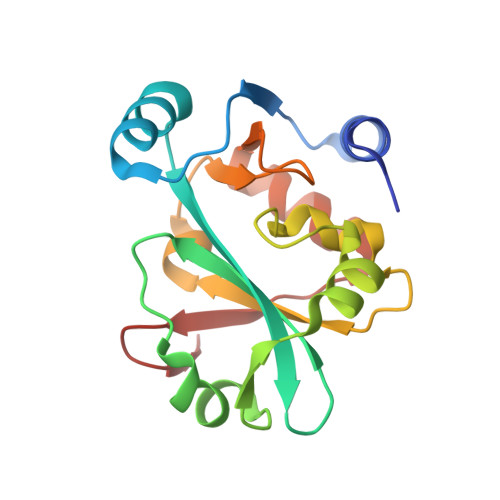Conformational and chemical selection by a trans-acting editing domain.
Danhart, E.M., Bakhtina, M., Cantara, W.A., Kuzmishin, A.B., Ma, X., Sanford, B.L., Kosutic, M., Goto, Y., Suga, H., Nakanishi, K., Micura, R., Foster, M.P., Musier-Forsyth, K.(2017) Proc Natl Acad Sci U S A 114: E6774-E6783
- PubMed: 28768811
- DOI: https://doi.org/10.1073/pnas.1703925114
- Primary Citation of Related Structures:
5VXB - PubMed Abstract:
Molecular sieves ensure proper pairing of tRNAs and amino acids during aminoacyl-tRNA biosynthesis, thereby avoiding detrimental effects of mistranslation on cell growth and viability. Mischarging errors are often corrected through the activity of specialized editing domains present in some aminoacyl-tRNA synthetases or via single-domain trans -editing proteins. ProXp-ala is a ubiquitous trans -editing enzyme that edits Ala-tRNA Pro , the product of Ala mischarging by prolyl-tRNA synthetase, although the structural basis for discrimination between correctly charged Pro-tRNA Pro and mischarged Ala-tRNA Ala is unclear. Deacylation assays using substrate analogs reveal that size discrimination is only one component of selectivity. We used NMR spectroscopy and sequence conservation to guide extensive site-directed mutagenesis of Caulobacter crescentus ProXp-ala, along with binding and deacylation assays to map specificity determinants. Chemical shift perturbations induced by an uncharged tRNA Pro acceptor stem mimic, microhelix Pro , or a nonhydrolyzable mischarged Ala-microhelix Pro substrate analog identified residues important for binding and deacylation. Backbone 15 N NMR relaxation experiments revealed dynamics for a helix flanking the substrate binding site in free ProXp-ala, likely reflecting sampling of open and closed conformations. Dynamics persist on binding to the uncharged microhelix, but are attenuated when the stably mischarged analog is bound. Computational docking and molecular dynamics simulations provide structural context for these findings and predict a role for the substrate primary α-amine group in substrate recognition. Overall, our results illuminate strategies used by a trans -editing domain to ensure acceptance of only mischarged Ala-tRNA Pro , including conformational selection by a dynamic helix, size-based exclusion, and optimal positioning of substrate chemical groups.
- Department of Chemistry and Biochemistry, The Ohio State University, Columbus, OH 43210.
Organizational Affiliation:
















